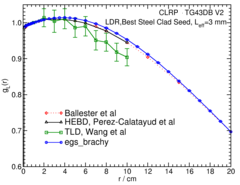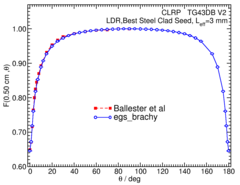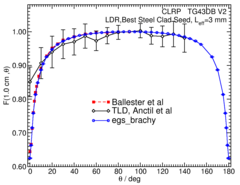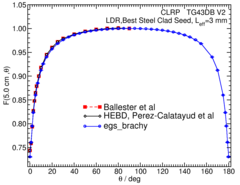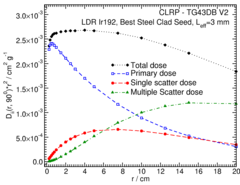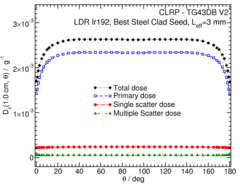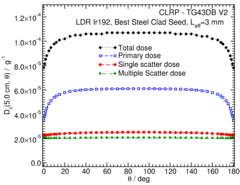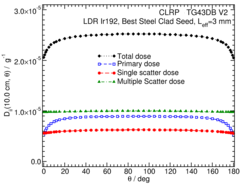
Source Description:
Dimensions for the Best 192Ir LDR steel-clad seed are taken from the studies by Williamson 1 and Perez-Calatayud et al 2. The source core consists of a 3 mm long active core (elemental composition by mass: 70% Pt, 30% Ir, with an assumed density of 21.68 g/cm3) with a diameter of 0.1 mm. The core is housed in a 0.2 mm thick cylindrical AISI 304 stainless steel capsule (density 8.02 g/cm3) with a total diameter of 0.5 mm, and a total length of 3 mm. The active length of this source is 3 mm. The mean photon energy calculated on the surface of the source is 355.44 keV with statistical uncertainties < 0.01%.
Dose-Rate Constant - Λ :
Dose-rate constants, Λ , are calculated by dividing the dose to water per history in a (0.1 mm)3 voxel centered on the reference position, (1 cm, Π/2), in a 80x80x80 cm3 water phantom, by the air-kerma strength per history factor (scored in vacuo). Air kerma per history is always calculated using a tracklength estimator in a 10x10x0.05 cm3 air voxel located in vacuo on the transverse axis 100 cm away from the source and then corrected (kr2 = 1.00217) for the lateral and thickness dimensions of the scoring voxel to give the air kerma per history on the central axis at a point 100 cm from the source’s mid-point as described in our previous study 3,4 . Low-energy photons emitted from the source encapsulation are suppressed in the air-kerma calculations by discarding all photons with energy less than 10 keV (i.e., PCUT set to 10 keV in EGSnrc).
Note: Decreasing PCUT to 5 (1) keV does not significantly change the value of the air kerma strength and dose-rate constant (difference~0.1% (0.08%))]. egs_brachy uncertainties are only statistical uncertainties (k=1).
| Author | Method | Λ (cGy h-1 U-1) | Abs. Uncertainty |
| Safigholi et al 5 | 10x10x0.5 cm3 voxel at 100 cm | 1.1149 | 0.0002 |
| Williamson 1 | Monte Carlo | 1.110 | 0.002 |
| Ballester et al 6 | GEANT4 | 1.112 | 0.001 |
| Anctil et al 7 | TLD | 1.110 | 0.029 |
| Wang & Sloboda 8 | EGS4 | 1.109 | 0.004 |
| Nath et al 9 | TLD | 1.09 | 0.03 |
| Mainegra et al 10 | EGS4 | 1.105 | 0.008 |
| Perez-Calatayud et al 2 | Consensus data | 1.110 | 0.015 |
| Papagiannis et al 10 | own MC code | 1.104 | 0.005 |
Radial dose function - g(r):
The radial dose function, g(r), is calculated using both line and point source geometry functions and tabulated at 36 different radial distances ranging from 0.2 cm to 20 cm.
Anisotropy function - F(r,θ):
Anisotropy functions are calculated using the line source approximation and tabulated at 13 radii from 0.25 cm to 20 cm and 47 unique polar angles with a resolution of 5° or better. The anisotropy factor, φan (r), was calculated by integrating the solid angle weighted dose rate over 0° ≤ ϑ ≤ 180°.
Along-Away Dose Data:
Along-away dose data are tabulated at 16 away distances from 0 cm to 20 cm and 29 along points from -20 cm to 20 cm. Doses are normalized to SK, the air-kerma strength.
Primary and Scatter Separated (PSS) Dose Data: D ii (r, θ):
Primary and Scatter Separated (PSS) dose data are tabulated at 12 radii from 0.3 cm to 20 cm and 47 unique polar angles with a resolution of 5° or better. High resolution (Δr = 1 mm, ΔΘ = 1°) primary scatter dose data are also available in .csv files. For the purposes of these calculations, any photon escaping the source encapsulation is considered a primary. Only photons which scatter within the phantom are counted in the scatter tallies. Doses are normalized to the total photon energy escaping the encapsulation. The "ii" subscript labeled in the Dii(r, θ) represent the total scatter as Dto (r, θ), the primary photons as Dpr (r, θ), the single scatter photon as Dss (r, θ), and the multiple scatter as Dms (r, θ).
High resolution (1mm/1°) Tabulated D ii (r,θ) data in .csv format: Zipped archive
Photon Energy Spectra
Photon energy spectra generated by the source model are calculated using the egs_brachy surface count scoring option to get the spectrum on the surface of the source. The plotted values are the counts per MeV in 1 keV bins, normalized to 1 count total in the spectrum. The MC calculations have a statistical uncertainty less than 0.001% on the mean energy. The spectrum data are available in xmgrace format below.
Photon energy spectrum on the source surface: xmgrace
Tabulated data:
Tabulated data are available in .xlsx format: Excel
References:
1. J. F. Williamson, Comparison of measured and calculated dose rates in water near I-125 and Ir-192 seeds, Med. Phys. 18, 776-786, 1991
2. Perez-Calatayud et al, Dose Calculation for Photon-Emitting Brachytherapy Sources with Average Energy Higher than 50 keV: Full Report of the AAPM and ESTRO, 2012, AAPM, ISBN: 978-1-936366-17-0
3. R. E. P. Taylor et al , Benchmarking BrachyDose: voxel-based EGSnrc Monte Carlo calculations of TG-43 dosimetry parameters, Med. Phys., 34 , 445 - 457, 2007
4. D. W. O. Rogers, Inverse square corrections for FACs and WAFACs, Appl. Radiat. Isot.,153 ,108638, 2019
5. H. Safigholi, M. J. P. Chamberland, R. E. P. Taylor, M. P. Martinov, D. W. O. Rogers, and R. M. Thomson, Update of the CLRP TG-43 parameter database for High Energy brachytherapy sources, to be published (Current calculation).
6. F. Ballester, D. Granero, J. Pérez-Calatayud, E. Casal, and V. Puchades, Monte Carlo dosimetric study of Best Industries and Alpha Omega Ir-192 brachytherapy seeds, Med. Phys. 31, 3298–3305, 2004
7. J. C. Anctil, B. G. Clark, and C. J. Arsenault, Experimental determination of dosimetry functions of Ir-192 sources, Med. Phys. 25, 2279–2287,1998.
8. R. Wang, X. A. Li, and C. X. Yu, Evaluation of EGS4/PRESTA multiple-scattering algorithms for 90Sr/90Y intravascular brachytherapy dosimetry, Phys.Med.Biol. 45, 2343,f 2352, 2000.
9. R. Nath, A S Meigooni, and J A. Meli, Dosimetry on transverse axes of 125I and 192Ir interstitial brachytherapy sources, Med. Phys.,17,1032-1040,1990 10. E Mainegra, R. Capote, and E Lopez, Dose rate constants for 125I, 103Pd, 192Ir and 169Yb brachytherapy sources: an EGS4 Monte Carlo study, Phys. Med. Biol.43,1557–1566,1998
11. P. Papagiannis et al, Dosimetry comparison of 192Ir sources Med. Phys. 29 (2002) 2239-2246
